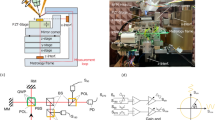Abstract
For nanoscale metrology using atomic force microscopy (AFM), it is essential to know the baseline error induced by the AFM scanning process. A systematic study has been performed using digital image correlation (DIC) to quantify the influence of scanning rotation angle on the artificial strain (error) in an open loop AFM. It is found that significant artificial strain has been induced by the scanning rotation angle, demonstrating that highly accurate metrology can only be performed in an open loop AFM when the scan angle is held constant during imaging.





Similar content being viewed by others
References
Troyan VI, Pushkin MA, Tronin VN, Borman VD, Krasovskii PA (2008) Metrology and standards in nanotechnology. Meas Tech 51:992–997
Tong W, Hector LG, Weiland H (1997) In-situ surface characterization of a binary aluminum alloy during tensile deformation. Scripta Mater 36:1339–1344
Cretegny L, Saxena A (2001) AFM Characterization of the evolution of surface deformation during fatigue in polycrystalline copper. Acta Mater 49:3755–3765
Chandrasekaran D, Nygards M (2003) A study of the surface deformation behavior at grain boundaries in an ultra-low-carbon steel. Acta Mater 51:5375–5384
Bobji MS, Bhushan B (2003) A technique to measure Poisson’s ratio of ultrathin polymeric films using atomic force microscopy. Rev Sci Instrum 74:1043–1047
Dasari A, Rohrmann J, Misra RDK (2003) Atomic force microscopy assessment of mechanically induced scratch damage in polypropylenses and ethylene-propylene di-block copolymers. Mater Sci Eng A 354:67–81
Chasiotis I, Fillmore HL, Gillies GT (2003) Atomic force microscopy measurement of cytostructural elements involved in the nanodynamics of tumor cell invasion. Nanotechnol 14:557–561
Chasiotis I, Knauss WG (2002) A new microtensile tester for the study of MEMS materials with the aid of atomic force microscopy. Exp Mech 42:51–57
Cho SW, Chasiotis I, Friedman TA, Sullivan J (2005) Young’s modulus, Poisson’s ratio and failure properties of tetrahedral amorphous diamond-like carbon for MEMS devices. J Micromech Microeng 15:728–735
Cho SW, Cardenas-Garcia JF, Chasiotis I (2005) Measurement of nanodisplacements and elastic properties of MEMS via the microscopic hole method. Sens Actuat A Phys 120:163–171
Cho SW, Chasiotis I (2007) Elastic properties and representative volume element of polycrystalline silicon for MEMS, Exp. Mech 47:37–49
Vogel D, Kuhnert R, Dost M, Michel B (2002) Determination of packaging material properties utilizing image correlation techniques. J Electr Pack 124:345–351
Li XD, Xu WJ, Sutton MA, Mello M (2006) Nanoscale deformation and cracking studies of advanced metal evaporated magnetic tapes using atomic force microscopy and digital image correlation techniques. Mater Sci Technol 22:835–844
Li XD, Xu WJ, Sutton MA, Mello M (2007) In situ nanoscale in-plane deformation studies of ultrathin polymeric films during tensile deformation using atomic force microscopy and digital image correlation techniques. IEEE Trans Nanotechnol 6:4–12
Xu ZH, Sutton MA, Li XD (2008) Mapping nanoscale wear field by combined atomic force microscopy and digital image correlation techniques. Acta Mater 56:6304–6309
Peters WH, Ranson WR (1982) Digital imaging techniques in experimental stress analysis. Opt Eng 21:427–432
McNeill SR, Sutton MA, Wolters WJ, Peters WH (1983) Determination of displacements using an improving digital correlation method. Image Vis Comput 1:1333–1339
Sutton MA, Cheng M, Peters WH, Chao YJ, McNeill SR (1986) Application of an optimized digital correlation method to planar deformation analysis. Image Vis Comput 4:143–153
Bruck HA, McNeill SR, Sutton MA, Peters WH (1989) Digital image correlation using Newton-Raphson method of partial differential correction. Exp Mech 29:262–267
Vendroux G, Knauss WG (1998) Submicron deformation field measurements: part 2. Improved digital image correlation. Exp Mech 38:86–91
Jin H, Bruck HA (2005) A new method for characterizing nonlinearity in scanning probe microscopes using digital image correlation. Nanotechnol 16:1849–1855
Sun Y, Pang JHL (2006) AFM image reconstruction for deformation measurements by digital image correlation. Nanotechnol 17:933–939
Xu ZH, Li XD, Sutton MA, Li N (2008) Drift and spatial distortion elimination in atomic force microscopy images by the digital image correlation technique. J Strain Anal Eng Design 43:729–743
Digital Instruments Veeco Metrology Group (2000) Nanoscope Command Reference Manual, Version 5.12, Revision B, 004-122-000.
Chasiotis I (2008) Chapter 17: atomic force microscopy in solid mechanics. In: Sharp WN Jr (ed), Handbook for experimental solid mechanics. Springer, p 409–443
Marinello F, Bariani P, Carmignato S, Savio E (2009) Geometrical modeling of scanning probe microscopes and characterization of errors. Meas Sci Technol 20:084013
Acknowledgements
This work was supported by the National Science Foundation (CMMI-0653651, CMMI-0968843, and CMMI-824728) and the University of South Carolina NanoCenter.
Author information
Authors and Affiliations
Corresponding author
Rights and permissions
About this article
Cite this article
Xu, ZH., Jin, H., Lu, WY. et al. Influence of Scanning Rotation on Nanoscale Artificial Strain in Open-Loop Atomic Force Microscopy. Exp Mech 51, 619–624 (2011). https://doi.org/10.1007/s11340-010-9442-3
Received:
Accepted:
Published:
Issue Date:
DOI: https://doi.org/10.1007/s11340-010-9442-3




